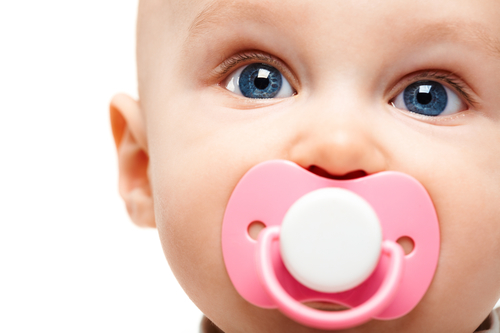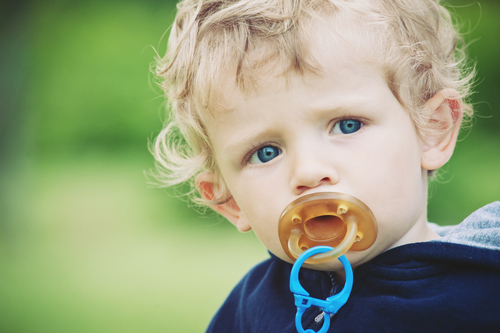 Does your little one fall asleep with a pacifier in their mouth and wake up when it falls out? If you put it back in quickly, do they go right back to sleep?
Does your little one fall asleep with a pacifier in their mouth and wake up when it falls out? If you put it back in quickly, do they go right back to sleep?
If it’s only happening a few times per night you may be perfectly fine being on pacifier duty. If, on the other hand, you’re popping it back in 10 or 15 or 20 times, you may be ready to teach your child to fall asleep without it.
The thought of taking away such a sure fire way of soothing your child to sleep may seem overwhelming. You may be especially ambivalent if you’ve read the AAP Safe Sleep Guidelines recommending pacifier use as a way to reduce the risk of SIDS. Like so many decisions that parents face, informed choice is key – weighing the pros and cons carefully will help you decide what’s best for your child and your family.
Even though it may seem daunting, eliminating the pacifier for sleep is usually not as painful as you may think. You can definitely expect a few rough nights as your child finds other ways to relax and fall asleep, but in conjunction with a sleep coaching plan that offers generous amounts of verbal and physical reassurance – hugs, holding, patting, etc. – you can minimize tears and offer loving support as they learn to sleep without it.
Important: Keep in mind that if your baby is under 4.5 months of age it’s important to focus on creating positive associations with sleep rather than trying to teach your baby sleep skills. Sleep training is not recommended for babies under 4.5 months of age. If your baby likes the pacifier, keep offering it, along with any other soothing strategies that work to keep your baby calm and rested. Soon they’ll be developmentally ready to learn to put themselves to sleep without as much assistance.
Between 4.5 and 6 months many healthy babies are ready to learn long term sleep skills. An experienced sleep consultant can help you to assess readiness, and will recommend that you check in with your pediatrician as well. Once you get the green light you can begin teaching your child to sleep without the pacifier by using a gentle sleep coaching method instead of offering the paci. If you’d prefer to take a more gradual approach you can try reducing pacifier use in stages instead, starting with bedtime only or bedtime and the first half of the night. Eventually you can work your way up to no pacifier for the entire night. Because daytime sleep is still developing in the 4.5 to 6 month period, it’s best to continue using the pacifier for naps in order to keep your child well rested. Believe it or not, babies are rarely confused by the inconsistency – they are remarkably good at understanding the differences between naps and nights!
By 7 or 8 months you have another option. Because at this age most babies have the ability to find their pacifier and re-plug it without assistance, you may decide that rather than eliminating the pacifier you’d rather teach your child to manage it on their own. Here’s how:
Start by putting 5 or 6 extra pacifiers in the corner of your child’s crib. Show your child where they are so they’ll know where to find them if they lose one during the night. A small plastic bowl can keep them from falling down the sides of the crib – or, if you prefer, you can just scatter them strategically across the mattress. If your child decides to make a sport out of throwing the pacifiers out (what better way to bring mommy or daddy back into the room!) wait until they’re asleep before placing the extras in the crib, and be clear about how many times you’re willing to hand them back once they hit the floor. Paci tossing can quickly become a game at this age, so unless you’re willing to play the game all night long it’s best to nip it in the bud and set a limit of one or two times.
- Nights One and Two: when your child wakes up and calls for you, respond quickly and place the pacifier in their hand instead of their mouth. Do this each time they wake throughout the night.
- Nights Three and Four: respond quickly, but instead of placing the pacifier in your child’s hand, push the pacifiers toward them instead. Invite them to pick the pacifier up themselves. Have patience. Resist the urge to place it in their hand. It may take a bit of coaxing, but eventually, if your child truly wants or need it, they’ll understand that they have to reach for it themselves.
- Nights Five and Six: if your child is still waiting for you to jump in and re-plug, respond quickly and simply point to the pacifiers. Use your voice to encourage them to pick it up themselves.
If you decide to eliminate the pacifier instead of teaching your child to take charge, it’s usually best at this age to work on the entire night all at once and then address naps after your child has mastered nights. Use a gentle coaching method at bedtime and for all wake ups that typically involve a paci re-plug.
If your child’s first birthday is looming, now is the time to decide if your child will be using the pacifier for sleep long term. After the first year the paci tends to take on a much deeper significance for most children (think the equivalent of a lovey) and taking it away will be much more upsetting and disruptive to their sleep. Expect that if you continue to allow your child to use it they’ll be attached to it for the next few years. If you’re okay with extended use, do your best to reserve the pacifier for sleep only. Keep it in the crib or on the nightstand to allow your child to develop other coping strategies during the day. Limiting use to sleep time only may also help to avoid some of the problems that can be associated with prolonged pacifier use like misalignment of teeth, re-shaping of the soft palate, speech problems and increased incidence of ear infections.
With 3+ year old’s, choose an uneventful time to say so long for good. Don’t do it the week that baby brother comes home from the hospital or your child transitions from a crib to a bed. Think carefully about the best way for your child and the pacifier to part ways, and look for an age appropriate book about giving up the pacifier that you can read to your child in preparation for the big night. Be sure to give your child a day or two of advance warning before sending their pacis to the new babies at the hospital or inviting the pacifier fairy into your home. Be sure to offer extra hugs and encouragement (and use a gentle coaching method if necessary) as your child adjusts to the change, and be extra sure that there aren’t any stray pacis hiding under the couch cushion that your child might discover and reunite with!
Sweet Dreams,
Alison Bevan – Sleepytime Coach
Pediatric Sleep Consultant – The Center For Advanced Pediatrics



























